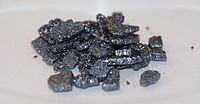
Photo from wikipedia
In order to implement oxide semiconductor-based complementary circuits, the improvement of the electrical properties of p-type oxide semiconductors and the performance of p-type oxide TFTs is certainly required. In this… Click to show full abstract
In order to implement oxide semiconductor-based complementary circuits, the improvement of the electrical properties of p-type oxide semiconductors and the performance of p-type oxide TFTs is certainly required. In this study, we report the effects of iodine doping on the structural and electrical characteristics of copper oxide (CuO) semiconductor films and the TFT performance. The CuO semiconductor films were fabricated using copper(II) acetate hydrate as a precursor to solution processing, and iodine doping was performed using vapor sublimated from solid iodine. Doped iodine penetrated the CuO film through grain boundaries, thereby inducing tensile stress in the film and increasing the film’s thickness. Iodine doping contributed to the improvement of the electrical properties of the solution-processed CuO semiconductor including increases in Hall mobility and hole-carrier concentration and a decrease in electrical resistivity. The CuO TFTs exhibited a conduction channel formation by holes, that is, p-type operation characteristics, and the TFT performance improved after iodine doping. Iodine doping was also found to be effective in reducing the counterclockwise hysteresis in the transfer characteristics of CuO TFTs. These results are explained by physicochemical reactions in which iodine replaces oxygen vacancies and oxygen atoms through the formation of iodide anions in CuO.
Journal Title: Materials
Year Published: 2021
Link to full text (if available)
Share on Social Media: Sign Up to like & get
recommendations!